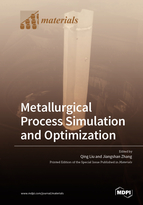Metallurgical Process Simulation and Optimization
A special issue of Materials (ISSN 1996-1944). This special issue belongs to the section "Metals and Alloys".
Deadline for manuscript submissions: closed (10 November 2022) | Viewed by 34160
Special Issue Editors
Interests: steelmaking; numerical modelling; simulation and optimization; metallurgical process engineering
Special Issues, Collections and Topics in MDPI journals
Interests: steelmaking; casting; simulation and modelling; intelligent metallurgy
Special Issues, Collections and Topics in MDPI journals
Special Issue Information
Dear Colleagues,
Metallurgy involves the art and science of extracting metals from their ores and modifying the metals for use. With thousands of years of development, many interdisciplinary technologies have been introduced into this traditional and large-scale industry. In modern metallurgical practices, modelling and simulation have been widely used to provide solutions for design, control, optimization, and visualization, and tend to be increasingly significant in the progress of digital transformation and intelligent metallurgy.
This Special Issue aims to provide an opportunity for researchers from both academia and industry to share their advances pertinent to the Special Issue “Metallurgical Process Simulation and Optimization,” which covers the process of electric/oxygen steelmaking, secondary metallurgy, (continuous) casting, and processing. Both fundamental insights and practical foresights are greatly welcome in the form of research article or review, such as thermodynamics, kinetics, physical modelling, numerical simulation, CFD, 3D visualization, microstructural evolution, quality control, artificial intelligence, big data, and cloud computation.
Prof. Dr. Qing Liu
Dr. Jiangshan Zhang
Guest Editors
Manuscript Submission Information
Manuscripts should be submitted online at www.mdpi.com by registering and logging in to this website. Once you are registered, click here to go to the submission form. Manuscripts can be submitted until the deadline. All submissions that pass pre-check are peer-reviewed. Accepted papers will be published continuously in the journal (as soon as accepted) and will be listed together on the special issue website. Research articles, review articles as well as short communications are invited. For planned papers, a title and short abstract (about 100 words) can be sent to the Editorial Office for announcement on this website.
Submitted manuscripts should not have been published previously, nor be under consideration for publication elsewhere (except conference proceedings papers). All manuscripts are thoroughly refereed through a single-blind peer-review process. A guide for authors and other relevant information for submission of manuscripts is available on the Instructions for Authors page. Materials is an international peer-reviewed open access semimonthly journal published by MDPI.
Please visit the Instructions for Authors page before submitting a manuscript. The Article Processing Charge (APC) for publication in this open access journal is 2600 CHF (Swiss Francs). Submitted papers should be well formatted and use good English. Authors may use MDPI's English editing service prior to publication or during author revisions.
Keywords
- thermodynamics and kinetics
- primary steelmaking and secondary metallurgy
- solidification and casting process
- microstructure and property
- metallurgical process engineering
- artificial intelligence, big data and cloud computation








